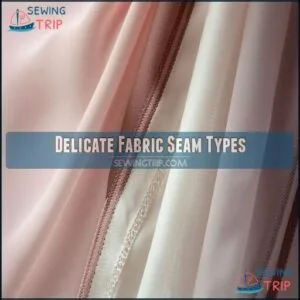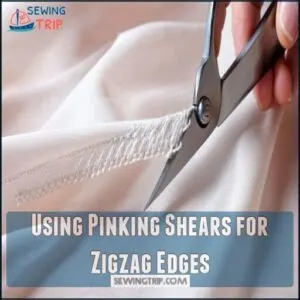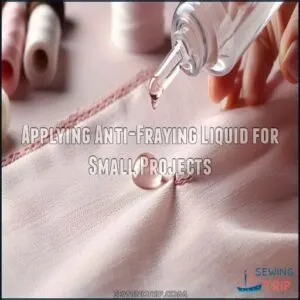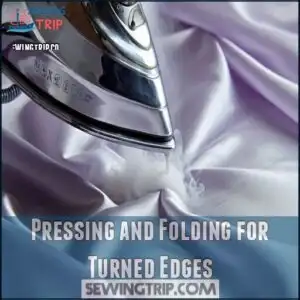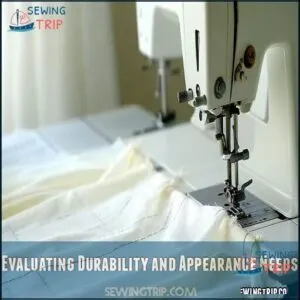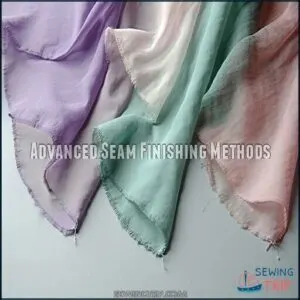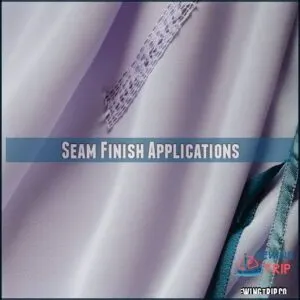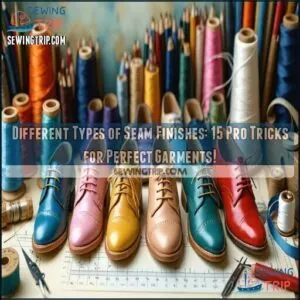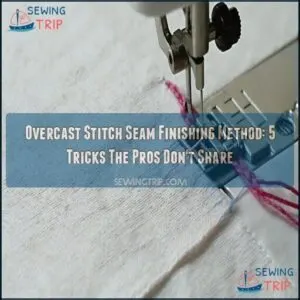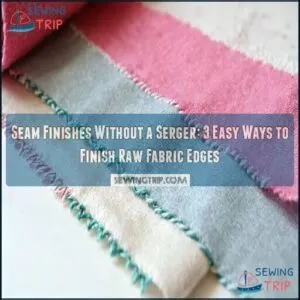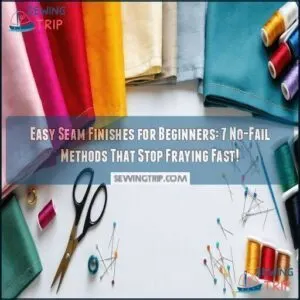This site is supported by our readers. We may earn a commission, at no cost to you, if you purchase through links.
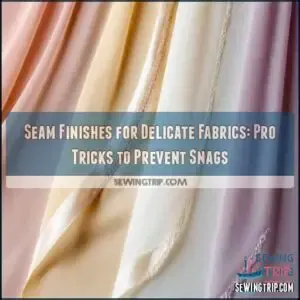
French seams are your secret weapon—they’ll neatly tuck away raw edges, preventing fraying while giving your garment a professional look.
For lightweight materials like chiffon or silk, try a zigzag stitch that hugs fabric edges without bulk.
Bound seams offer another elegant solution, creating a clean finish that’s both durable and sophisticated.
Remember, the right seam technique can transform fragile fabrics from vulnerable to victorious, ensuring your delicate creations stay pristine through countless wears and washes.
Mastering these techniques isn’t just sewing—it’s textile artistry.
Table Of Contents
Key Takeaways
- You’ll want to match your seam finish to your fabric’s specific weight and opacity, using techniques like French seams for chiffon or zigzag stitching for lightweight materials to prevent fraying and maintain the fabric’s delicate nature.
- Your choice of thread and needle matters critically – select fine, lightweight polyester or silk thread that matches your fabric, and always use a delicate needle to prevent puckering and achieve professional-looking results.
- You can prevent fabric damage by experimenting with multiple finishing techniques like bias tape, pinking shears, and anti-fraying liquids, which will give you flexibility in protecting raw edges without compromising your fabric’s elegant drape.
- You’ll elevate your sewing by understanding that seam finishing isn’t just technical – it’s an art form that requires precision, careful testing on scrap fabric, and a nuanced approach to preserving the integrity of delicate textiles.
Delicate Fabric Seam Types
When working with delicate fabrics, choosing the right seam type is key to preventing fraying and achieving a polished look.
Delicate fabrics whisper elegance when seams are crafted with precision and care.
Techniques like French seams, Hong Kong finishes, and zigzag stitching offer both durability and elegance for lightweight or sheer materials.
French Seams for Lightweight Fabrics
Let’s nail down those French seams for lightweight fabrics.
When working with delicate materials like chiffon or organza, you’ll want to master this elegant seam finish.
French seams reduce bulk, provide stunning aesthetic appeal, and create a professional look.
By encasing raw edges, you’ll guarantee your fabric’s durability while maintaining a sleek, refined appearance.
They’re also ideal because raw edges are enclosed, which is a key aspect of working with delicate materials.
Hong Kong Seams for Sheer Fabrics
Here are three compelling Hong Kong seam techniques for your sheer fabrics that’ll transform your sewing game. Choose your approach wisely:
- Pin bias tape against seam allowances precisely
- Trim edges for minimal bulk
- Stitch through all layers with 1/4" seam
- Create professional edge enclosure
A Hong Kong finish reduces bulk while delivering a couture-level treatment for delicate chiffon and lightweight materials.
Master this technique to elevate your garment’s interior elegance.
Zigzag Stitching for Delicate Edges
After mastering Hong Kong seams, you’ll want to tackle zigzag stitching for delicate fabric edges.
Adjust your machine’s stitch width and tension carefully to prevent puckering. Practice on scrap fabric, keeping the material taut while sewing.
Use backstitching for security, and watch those raw edges transform. Your zigzag stitch becomes a trusty fray-prevention superhero for lightweight materials.
Preventing Fraying Techniques
When working with delicate fabrics, you’ll want to master techniques that prevent unsightly fraying and keep your garments looking professional.
Pinking shears, anti-fraying liquids, and careful pressing can transform your seam finishes from amateur to expert-level in just a few simple steps, utilizing techniques that are easy to learn.
Using Pinking Shears for Zigzag Edges
After perfecting your French seams, grab those trusty pinking shears for an elegant fray prevention solution.
Angle matters when cutting delicate fabrics—hold them steady and slice with precision. Sharp blades create clean zigzag edges that minimize fabric unraveling.
Pro tip: practice on scrap material to master your cutting technique and protect those precious textiles from unwanted fraying.
Mastering the use of pinking shears on a project requires understanding the importance of proper fabric preparation techniques, which is a critical step in ensuring the longevity of your delicate fabrics and achieving a professional finish with precision cutting.
Applying Anti-Fraying Liquid for Small Projects
When working with delicate fabrics, anti-fraying liquid can be your secret weapon for preventing unraveling edges.
Here’s why you’ll love this technique:
- Saves your precious projects from falling apart
- Provides a professional, clean finish in seconds
- Works like magic on tiny fabric details
- Gives you confidence to tackle intricate designs
Test first on scrap fabric, apply sparingly, and watch your delicate fabric seams stay perfectly intact.
You can find various brands available online, which makes it easy to get started with this simple yet effective technique and achieve a clean finish.
Pressing and Folding for Turned Edges
After taming fraying edges with anti-fraying liquid, you’ll want to master the art of pressing and folding.
Your iron becomes a precision tool for delicate fabrics, transforming raw edges into crisp, secure lines.
Here’s a quick guide to edge sharpness and fabric creasing:
| Technique | Key Considerations |
|---|---|
| Steam Usage | Adjust for fabric weight |
| Iron Temperature | Low for silk, medium for cotton |
| Fold Alignment | Precise, even edges |
| Securing Folds | Gentle pressure |
| Final Check | Smooth, flat seam |
Choosing Right Seam Finish
When working with delicate fabrics, you’ll want to choose a seam finish that matches your fabric’s unique characteristics and project needs.
Your goal is to select a technique that prevents fraying, enhances durability, and maintains the fabric’s elegant appearance without adding unnecessary bulk or complexity, using a method that enhances durability.
Considering Fabric Weight and Opacity
After battling fraying edges, you’ll want to zero in on fabric weight and opacity.
Sheer chiffon demands different seam strategies than heavyweight denim.
Lighter fabrics like organza need whisper-thin finishes, while robust materials can handle more aggressive techniques.
Understanding fabric weight considerations is essential for selecting the proper finish.
Your fabric’s drape and layering effects will guide your seam finish choice, ensuring a professional result that respects each fabric’s unique personality, and considers the importance of seam strategies.
Selecting Seam Finish for Fabric Type
After exploring fabric weight, let’s zero in on matching seam finishes to your fabric’s unique personality.
Selecting the right seam finish isn’t just technical—it’s an art form that transforms your project’s look and longevity.
Consider these key factors:
- Chiffon craves delicate French seams
- Silk demands precise, narrow enclosures
- Organza requires near-invisible techniques
- Lightweight fabrics need minimal bulk
- Sheer materials call for subtle finishes
Evaluating Durability and Appearance Needs
When selecting seam finishes, consider your garment’s fabric lifespan and aesthetic preferences.
Your fabric’s durability depends on wear frequency and maintenance requirements. Sheer fabrics like chiffon and organza demand gentler treatments, while silk requires precise, delicate handling.
To prevent unraveling, consider that a key purpose of seam finishes is to secure raw fabric edges.
Match your seam finish to the garment’s purpose, ensuring both strength and elegance in every stitch.
Advanced Seam Finishing Methods
When working with delicate fabrics, you’ll want to master advanced seam finishing methods that protect your garments from unsightly fraying and potential damage.
These professional techniques will elevate your sewing skills, ensuring your most fragile materials stay intact and look impeccably polished.
Flat-Felled Seams for Durability
After choosing the right seam finish, you’ll want to master flat-felled seams for ultimate durability. This industrial-strength technique transforms your project’s strength and appearance, especially with bulky fabrics.
- Perfect for heavyweight materials like denim and canvas
- Creates a clean, professional finish that resists wear
- Ideal for high-stress areas in garments
Topstitching options and double-needle techniques elevate these seams from basic to extraordinary, giving your silk, chiffon, and organza pieces a couture-level edge.
Bound Seam Finishes for Elevated Garments
After mastering flat-felled seams, take your garment game up a notch with bias bound seams. These couture-level finishes wrap raw edges in beautiful binding, transforming delicate fabrics like chiffon and silk.
Master bias bound seams to transform delicate fabrics with couture-level elegance and precision.
You’ll create strong, clean seams that look professional on both sides. For a truly polished look, consider Hong Kong seam finishes.
Perfect for jackets and unlined skirts, bound seams offer durability with stunning decorative potential.
Decorative Overlocking for Raw Edges
Dress up your raw edges with decorative overlocking that turns functional seam finishes into fashion statements.
Experiment with thread color and stitch variations to add flair to delicate fabrics.
Adjust tension settings carefully to maintain edge stability, creating professional-looking serged edges that elevate your project from ordinary to extraordinary. Your serger becomes a creative tool for unique seam finishes.
Seam Finish Applications
When working with delicate fabrics, you’ll want to choose seam finishes that protect your garment’s edges without adding bulk or compromising its lightweight nature.
Your goal is to select techniques like French seams, Hong Kong finishes, or strategic zigzag stitching that’ll prevent fraying while maintaining the fabric’s elegant drape.
Using Bias Tape for Clean Finishes
Precision meets elegance when you master bias tape finishes for delicate fabrics.
Single-fold or double-fold bias tape transforms raw edges on chiffon, organza, and silk with professional flair.
You’ll want to carefully align the tape, pin with precision, and press each seam for crisp, clean results that elevate your garment’s finish and prevent fraying along curved edges.
Consider using bias tape specifically designed for delicate materials.
Mock French Seams for Quicker Results
If you’re looking for a lightweight alternative to traditional French seams, mock French seams are your new best friend.
These clever techniques offer a faster method for finishing delicate fabrics like chiffon and silk.
- Perfect for sheer fabrics with minimal bulk
- Uses tissue paper for precision stitching
- Achieves a discrete finish with narrow zigzag
Your projects will thank you for this innovative approach to finishing seams, and it’s a great way to give your work a professional touch with minimal bulk.
Applying Zigzag Stitch for Versatile Finishes
Left off by perfecting quick mock French seams? Now let’s amp up your zigzag stitch game! Your sewing machine’s most versatile ally awaits, transforming sheer fabrics like chiffon and organza with professional flair.
| Stitch Setting | Fabric Type | Tension | Width | Result |
|---|---|---|---|---|
| Narrow | Lightweight | Low | 1.5mm | Delicate |
| Medium | Medium | Medium | 2.5mm | Balanced |
| Wide | Heavy | High | 3.5mm | Sturdy |
| Narrow | Silk | Low | 1.0mm | Precise |
| Medium | Organza | Medium | 2.0mm | Clean |
Backstitching seams guarantees a polished finish that won’t unravel, which is essential for working with sheer fabrics.
Frequently Asked Questions (FAQs)
How can I prevent puckering when sewing delicates?
Adjust your machine’s tension and use a fine needle when sewing delicates.
Try tissue paper underneath, select lightweight thread, and stitch slowly to prevent puckering.
Test on scrap fabric first for best results.
Do serger machines work better than zigzag?
Cut to the chase, sergers outshine zigzag machines for delicate fabrics.
They’re faster, create professional edges, and handle lightweight materials with ease, preventing fraying without compromising fabric integrity or causing unwanted tension, which makes them ideal for delicate fabrics and allows for professional edges.
What tools protect fabric during seam finishing?
You’ll want pinking shears, fray-check liquid, tissue paper, and seam sealant to protect delicate fabric edges.
These tools prevent unraveling, stabilize seams, and create clean, professional finishes without damaging lightweight or fragile materials, which helps to achieve a professional finish.
Can I mix seam finishing techniques together?
Imagine weaving magic with your seams.
You can absolutely mix techniques, blending French seams with zigzag stitches or bias tape finishes.
Just test on scrap fabric first to verify compatibility and achieve your desired professional look.
How do I choose thread for delicates?
Choose lightweight, fine polyester or silk thread that matches your delicate fabric.
Select a thin, strong thread matching the color.
Test tension on a scrap piece to prevent puckering and guarantee smooth, even stitching.
Conclusion
Seam Smartly, Sew Supremely! Mastering seam finishes for delicate fabrics isn’t just a skill—it’s an art form.
You’ll transform fragile textiles into professional-looking garments by understanding each technique’s nuanced application.
Whether you’re using French seams, zigzag stitches, or bound edges, your careful approach prevents fraying and elevates your sewing.
Remember, the right seam finish can make the difference between an amateur project and a couture-worthy creation.
Precision is your greatest ally in textile craftsmanship, and it will help you achieve a professional finish by ensuring that every detail is carefully considered.

